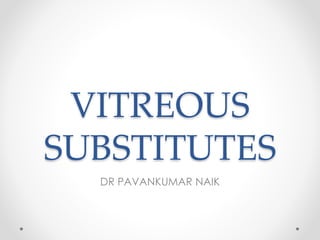This document discusses various vitreous substitutes and intraocular gases used to replace the vitreous humor after surgery. It describes the anatomy and composition of the natural vitreous and ideal properties for substitutes. Common substitutes discussed include gases like air, sulfur hexafluoride and perfluorocarbons; liquids like silicone oil, perfluorocarbon liquids and semi-fluorinated alkanes; and experimental polymers and implants. The document compares different options and provides details on how each works, associated complications, and appropriate uses.



































































